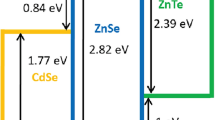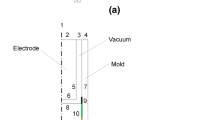Abstract
The influence of the initial composition of a CF4 + CHF3 + Ar mixture and bias power on the electrical parameters of the plasma, the composition of the gas phase, and the kinetics of heterogeneous processes on the treated surface under conditions of an induction RF (13.56 MHz) discharge is studied. It is found that the variation of the CF4/CHF3 ratio does not lead to significant perturbations of the parameters of the electronic and ionic components of the plasma, but significantly changes the concentrations of fluorine atoms and polymer-forming radicals. In contrast, an increase in the bias power at a fixed initial composition of the mixture has practically no effect on the concentrations of active particles, but is characterized by a proportional change in the energy of the bombarding ions. The model analysis of the kinetics of heterogeneous processes shows that the CF4/CHF3 ratio provides wider ranges of regulation of the etching rate of the base material, as well as the deposition rate of the fluorocarbon polymer film and its thickness.



Similar content being viewed by others
REFERENCES
Rooth, J.R., Industrial Plasma Engineering, Vol. 2: Applications to Nonthermal Plasma Processing, Bristol: IOP, 2001.
Roosmalen, J., Baggerman, J.A.G., and Brader, S.J., Dry Etching for VLSI, New York: Plenum, 1991.
Nojiri, K., Dry Etching Technology for Semiconductors, Tokyo: Springer Int., 2015.
Lieberman, M.A. and Lichtenberg, A.J., Principles of Plasma Discharges and Materials Processing, New York: Wiley, 1994.
Kay, E., Coburn, J., and Dilks, A., Plasma chemistry of fluorocarbons as related to plasma etching and plasma polymerization, in Plasma Chemistry III, Veprek, S. and Venugopalan, M., Eds., Vol. 94 of Topics in Current Chemistry, Berlin: Springer, 1980.
Coburn, J.W., Plasma Etching and Reactive Ion Etching, New York: AVS Monograph Ser., 1982.
Standaert, T.E.F.M., Hedlund, C., Joseph, E.A., Oehrlein, G.S., and Dalton, T.J., Role of fluorocarbon film formation in the etching of silicon, silicon dioxide, silicon nitride, and amorphous hydrogenated silicon carbide, J. Vac. Sci. Technol. A, 2004, vol. 22, pp. 53–60.
Stoffels, W.W., Stoffels, E., and Tachibana, K., Polymerization of fluorocarbons in reactive ion etching plasmas, J. Vac. Sci. Technol. A, 1998, vol. 16, pp. 87–95.
Matsui, M., Tatsumi, T., and Sekine, M., Relationship of etch reaction and reactive species flux in C4F8–Ar–O2 plasma for SiO2 selective etching over Si and Si3N4, J. Vac. Sci. Technol. A, 2001, vol. 19, pp. 2089–2096.
Efremov, A.M., Murin, D.B., and Kwon, K.H., Concerning the effect of type of fluorocarbon gas on the output characteristics of the reactive-ion etching process, Russ. Microelectron., 2020, vol. 49, no. 3, pp. 157–165.
Rauf, S. and Ventzek, P.L.G., Model for an inductively coupled Ar/C–C4F8 plasma discharge, J. Vac. Sci. Technol., A, 2002, vol. 20, pp. 14–23.
Efremov, A.M., Murin, D.B., and Kwon, K.-H., Features of the kinetics of bulk and heterogeneous processes in CHF3 + Ar and C4F8 + Ar plasma mixtures, Russ. Microelectron., 2019, vol. 48, no. 2, pp. 119–127.
Kimura, T. and Noto, M., Experimental study and global model of inductively coupled CF4/O2 discharges, J. Appl. Phys., 2006, vol. 100, pp. 063303-1–9.
Kimura, T. and Ohe, K., Probe measurements and global model of inductively coupled Ar/CF4 discharges, Plasma Sources Sci. Technol., 1999, vol. 8, pp. 553–560.
Efremov, A., Lee, B.J., and Kwon, K.-H., On relationships between gas-phase chemistry and reactive-ion etching kinetics for silicon-based thin films (SiC, SiO2 and SixNy) in multi-component fluorocarbon gas mixtures, Materials, 2021, vol. 14, pp. 1432-1–27.
Efremov, A., Lee, J., and Kwon, K.-H., A comparative study of CF4, Cl2 and HBr + Ar inductively coupled plasmas for dry etching applications, Thin Solid Films, 2017, vol. 629, pp. 39–48.
Li, X., Ling, L., Hua, X., Fukasawa, M., Oehrlein, G.S., Barela, M., and Anderson, H.M., Effects of Ar and O2 additives on SiO2 etching in C4F8-based plasmas, J. Vac. Sci. Technol. A, 2003, vol. 21, pp. 284–293.
Chun, I., Efremov, A., Yeom, G.Y., and Kwon, K.-H., A comparative study of CF4/O2/Ar and C4F8/O2/Ar plasmas for dry etching applications, Thin Solid Films, 2015, vol. 579, pp. 136–148.
Efremov, A., Lee, J., and Kim, J., On the control of plasma parameters and active species kinetics in CF4 + O2 + Ar gas mixture by CF4/O2 and O2/Ar mixing ratios, Plasma Chem. Plasma Process., 2017, vol. 37, pp. 1445–1462.
Shun’ko, E.V., Langmuir Probe in Theory and Practice, Boca Raton: Universal, 2008.
Efremov, A.M., Murin, D.B., and Kwon, K.-H., Parameters of plasma and kinetics of active particles in CF4(CHF3) + Ar mixtures of a variable initial composition, Russ. Microelectron., 2018, vol. 47, no. 6, pp. 414–423.
Ho, P., Johannes, J.E., and Buss, R.J., Modeling the plasma chemistry of C2F6 and CHF3 etching of silicon dioxide, with comparisons to etch rate and diagnostic data, J. Vac. Sci. Technol. A, 2001, vol. 19, pp. 2344–2367.
Gray, D.C., Tepermeister, I., and Sawin, H.H., Phenomenological modeling of ion enhanced surface kinetics in fluorine-based plasma etching, J. Vac. Sci. Technol. B, 1993, vol. 11, pp. 1243–1257.
Lee, C., Graves, D.B., and Lieberman, M.A., Role of etch products in polysilicon etching in a high-density chlorine discharge, Plasma Chem. Plasma Process, 1996, vol. 16, pp. 99–118.
Handbook of Chemistry and Physics, Boca Raton, FL: CRC, 1998.
Funding
The work was supported within the framework of the state task of the Federal State Institution, Federal Scientific Cente, Research Institute of Civil Engineering, Russian Academy of Sciences (Conducting fundamental scientific research (47 GP)) on research topic no. 11021060909091-4-1.2.1 “Fundamental and applied research in the field of lithographic limits of semiconductor technologies and physicochemical processes of etching 3D nanometer dielectric structures for the development of critical technologies for the production of electronic components. Research and construction of models and designs of microelectronic elements in an extended temperature range (from –60 to +300°С) (FNEF-2022-0006).”
Author information
Authors and Affiliations
Corresponding author
Ethics declarations
The authors declare that they have no conflicts of interest.
Rights and permissions
About this article
Cite this article
Efremov, A.M., Betelin, V.B. & Kwon, KH. On the Mechanisms Regulating the Plasma Composition and Kinetics of Heterogeneous Processes in a CF4 + CHF3 + Ar Mixture. Russ Microelectron 51, 302–310 (2022). https://doi.org/10.1134/S1063739722050055
Received:
Revised:
Accepted:
Published:
Issue Date:
DOI: https://doi.org/10.1134/S1063739722050055




